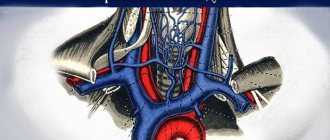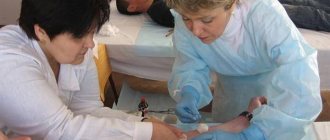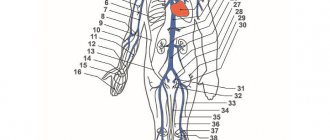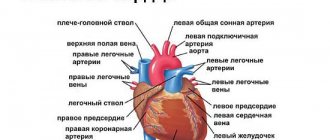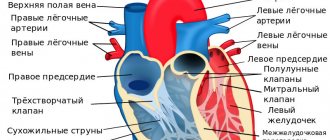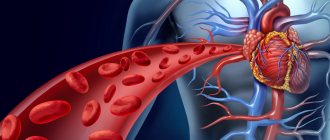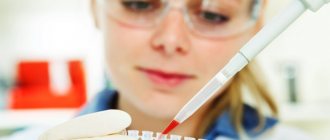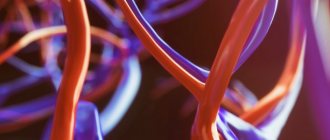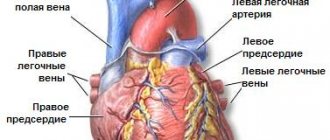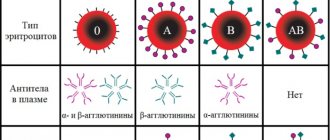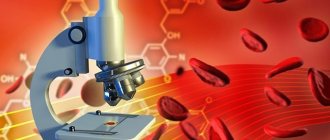What is blood
Blood should be understood as the liquid internal environment of the body, which ensures the constancy of key biochemical and physiological parameters, while providing a humoral connection between organs. When studying blood, its composition and functions, it is important to understand the essence of two basic terms:
- peripheral blood (it consists of plasma);
- formed elements (located in a suspended state inside the blood).
Blood can also be defined as a unique form of tissue, characterized by several features: its components have different origins, this liquid medium of the body is in constant motion, all elements of blood are formed and destroyed outside the blood flow itself.
Within the framework of the topic: “Blood system, composition and functions,” it is worth noting that this system includes hematopoietic and hematopoietic organs (liver, bone marrow, lymph nodes, spleen), as well as peripheral blood.
Blood loss and consequences
The human body is prudent, and not all blood constantly circulates in the human body, performing its functions. The body also has so-called blood depots (reserves), where it is stored in case of special need. Blood is stored in the spleen, liver, and a number of other organs, and with heavy blood loss, as well as in stressful situations, it can be released into the general bloodstream. However, even this reserve may not be enough if we are talking about severe bleeding and large blood losses. This applies primarily to arterial and severe venous bleeding. Every person should be able to recognize them so that, if necessary, they can help themselves and their loved ones .
Interesting: Why don't people celebrate 40 years? Reasons, photos and videos
For arterial bleeding, which is especially dangerous and can lead to death. In this case, it is necessary to apply a tourniquet and immediately hospitalize the person. The tourniquet can only be applied for 2 hours, in cold weather - no more than an hour, otherwise there is a risk of necrosis and limb loss. In case of venous bleeding, when dark blood flows in a continuous stream, it is necessary to apply a pressure bandage and also consult a doctor.
Chronic blood loss
In addition to such bleeding, which usually occurs due to injuries, there is another category - chronic blood loss. They occur during oncological tumors, ulcers, hemorrhoids and other phenomena. Symptoms develop gradually, because the body initially strives to compensate for losses. This phenomenon leads to anemia, constant fatigue and loss of strength, dizziness, pallor, and problems with the immune system. It is necessary to establish the cause of these disorders and undergo treatment, after which the blood condition will improve.
Blood is the most important fluid in the body, and it contains from 3 to 5 or more liters. But losing more than 30 percent of blood is fraught with serious consequences . It is worth taking care of your health and not risking it.
Blood composition
Most of the blood - 60% - is plasma, and only 40% is filled with elements such as red blood cells, white blood cells and platelets. A viscous, thick liquid (plasma) contains substances important for the functioning of the body. They move through tissues and organs, ensuring the desired chemical reaction and the full functioning of the entire nervous system. Hormones produced by the endocrine glands enter the plasma and are then distributed throughout the body through the bloodstream. Antibodies - enzymes that protect the body from various types of threats - are found in plasma.
Red blood cells
When considering the composition and main functions of blood, it is necessary to pay attention to red blood cells. These are red blood cells that determine the color of blood. In its structure, an erythrocyte is very similar to a thin sponge, in the pores of which there is hemoglobin. On average, each red blood cell is capable of carrying 267 million particles of hemoglobin, which “swallows” carbon dioxide and oxygen and combines with them.
Delving deeper into the topic: “Composition and functions of blood: red blood cells,” you need to understand that these particles can carry large amounts of hemoglobin due to their nuclear-free structure. As for the size of the red blood cell, they reach 8 micrometers in length and 3 micrometers in width. Moreover, the number of red blood cells is, without exaggeration, enormous: every second more than 2 million of these particles are formed in the bone marrow, their total mass in the body is approximately 26 trillion.
Hematopoiesis
Hematopoiesis is the formation of cellular elements that occurs in the blood. Leukocytes are formed by a process called leukopoiesis, red blood cells - erythropoiesis, platelets - thrombopoiesis. The growth of blood cells occurs in the bone marrow, which is located in flat and tubular bones. Lymphocytes are formed, in addition to bone marrow, also in the intestinal lymph tissue, tonsils, spleen and lymph nodes.
Circulating blood always maintains a relatively stable volume, the function it performs is so important, despite the fact that something is constantly changing inside the body. For example, fluid is constantly absorbed from the intestines. And if water enters the blood in a large volume, then some of it immediately leaves with the help of the kidneys, the other part enters the tissues, from where over time it again penetrates into the bloodstream and is completely released through the kidneys.
If not enough fluid enters the body, the blood receives water from the tissues. In this case, the kidneys do not function at full capacity, they collect less urine, and little water is excreted from the body. If the total blood volume decreases by at least a third in a short period of time, say, bleeding occurs or as a result of an injury, then this is already life-threatening.
Leukocytes
These elements are also integral components of blood flow. Leukocytes are white blood cells, the size of which can vary. They have a rounded irregular shape. Since leukocytes are particles with a nucleus, they are able to move independently. There are significantly fewer of them than red blood cells, but leukocytes are actively involved in the function of protecting the body from infections. Blood composition and blood functions cannot be complete without white blood cells.
Leukocytes have special enzymes that are capable of binding and breaking down breakdown products and foreign protein substances, as well as absorbing dangerous microorganisms. In addition, some forms of leukocytes can produce antibodies - protein particles that perform one of the important functions: defeating any foreign microorganisms that enter the blood, mucous membranes and other tissues or organs.
Shaped elements
Erythrocytes are also called red blood cells because of the pigment they contain - hemoglobin. The only function of these disc-shaped formations is to transport oxygen from the lungs to the cells of the body, as well as the reverse transfer of carbon dioxide. Due to their elasticity and small size, they are able to penetrate the thinnest capillaries.
A feature of the erythrocytes of all mammals is the absence of a nucleus and most of the internal formations, as well as an extensive surface of contact with the external environment. They are not able to move independently and move with the help of plasma. Thanks to this structure, red cells perform their task of transporting gases with maximum efficiency.
Red blood cells are constantly renewed at a rate of more than 2 million per second. The life cycle of one unit is a little more than 4 months. In total, the human body contains about 25 billion red blood cells.
Leukocytes, or white cells, differ from red blood cells in their more complex internal structure, size and lack of color. They move freely through the circulatory system in any direction, protecting the body from invading enemy elements. If necessary, these cells leak through the walls of the capillaries and are able to enter the intercellular environment.
White blood cells are the general name for a group of guard cells. Some of them are engaged in the capture and absorption of foreign microbes (phagocytosis), while others produce the necessary antibodies.
White cells, depending on their structure, are usually divided into 2 groups:
- Grainy.
- Non-grainy.
The concentration of leukocytes is a thousand times less than that of erythrocytes. It may fluctuate throughout the day. For example, after eating, a stressful situation or heavy exercise, the number of white blood cells in the blood increases.
Platelets used to be called platelets. These colorless formed elements, like red blood cells, do not have a nucleus. In its normal state, the cell is a small flattened ball.
Functions of a platelet:
- formation of a plug to block damage in the circulatory system;
- acceleration of plasma coagulation.
The main feature of the blood plate is its ability to change under the influence of collagen or environmental disturbances. Activated platelets attach to the damaged area and intertwine with each other to form blood clots.
Platelets
These blood platelets move in close proximity to the walls of blood vessels. Their main function is to restore blood vessels in case of damage. If we use medical terminology, we can say that platelets are actively involved in ensuring hemostasis (blood clotting). There are on average more than 500 thousand of these particles per cubic millimeter. Platelets live shorter than other blood elements - from 4 to 7 days.
They move freely along with the blood flow and linger only in those places where the blood flow goes into a calmer state (spleen, liver, subcutaneous tissue). At the moment of activation, the platelet shape becomes spherical, and pseudopodia (special outgrowths) are formed. It is with the help of pseudopodia that these blood elements are able to connect with each other and be fixed at the site of damage to the vessel wall.
Blood composition and blood function should be considered only taking into account the action of platelets.
Lymphocytes
This term refers to small mononuclear cells. Lymphocytes for the most part have a size of up to 10 microns. The nuclei of such cells are round and dense, and the cytoplasm consists of small granules and is colored bluish. Upon superficial examination, you will notice that all lymphocytes have the same appearance. This does not change the following fact - they differ in the properties of the cell membrane and their functions.
These mononuclear blood cells are divided into three main categories: O cells, B cells and T cells. The function of B lymphocytes is to serve as precursor cells that make antibodies. In turn, T cells ensure the transformation of B leukocytes. It is worth noting that T lymphocytes are a specific group of immune system cells that perform several important functions. For example, with their participation, the process of synthesizing macrophage activation factors and interferon growth factors, as well as B cells, occurs. Inducer T cells can also be isolated, which are involved in stimulating the formation of antibodies. Using the example of the action of various categories of lymphocytes, the relationship between the composition and function of the blood is clearly visible.
As for 0 cells, they differ significantly from the rest because they do not have surface antigens. Some of these blood elements perform the function of “natural killers,” destroying those cells that have a cancerous structure or are infected with a virus.
Blood plasma
The composition of blood plasma includes water (90-90%) and solids: proteins, fats, glucose, various salts, metabolic products, vitamins, hormones, etc. One of the key properties of plasma is osmotic pressure. Plasma also transports nutrients, blood cells, and metabolic products. Studying the composition and functions of blood plasma , you can see that it serves as a link between fluids that are located outside the blood vessels.
Plasma is in constant contact with the kidneys, liver and other organs, thereby maintaining homeostasis - the constancy of the internal environment of the body.
Protein composition
Proteins are divided into proteins and nitrogenous compounds. The following types and composition of proteins are distinguished:
- Albumin in the blood . Formed in the liver. They account for about 60% of protein compounds;
- Globulins . They are formed not only in the liver. The medula, lienis, and lympha node take part in the synthesis of globulins. Globulins account for 34% of blood proteins;
- Fibrinogen in the blood. Synthesized by the liver. Takes part in thrombus formation. The share in the total amount of proteins is 6%.
Albumins (albuminis—protein) belong to the group of simple water-soluble low-molecular proteins. They are considered a plastic material for the synthesis of individual amino acids, as well as protein depots. Albumin maintains osmotic pressure, which retains water inside the vessel. Albuminis transports cholesterol in the blood, higher carboxylic acids, their compounds, bilirubin pigment, metals and medicinal substances.
Globulins (globulus—ball) are less soluble in water than albumins and have a higher molecular weight. Three fractions of globular blood proteins are known:
- α-globulins are found in the blood in the form of glycoproteins—chemical compounds with sugars. They transport fats, hormones, vitamins, microelements;
- β-globulins transport iron, sex hormones, cephalins, lecithins, procoagulants;
- γ-globulins form antibodies, blood group agglutinins.
Fibrinogen plays a major role in blood clotting.
The plasma content of proteins and their fractions, as well as lipoproteins, must be taken into account when choosing medications, since the formation of inactive protein compounds with drug components is possible. This concerns, first of all, the problem of compatibility of several medications taken simultaneously.
Protein molecules in blood plasma perform the following important functions in the body:
- Development of antibodies in the blood against foreign agents invading from outside;
- Maintaining optimal blood concentration for biochemical transformations;
- Manifestation of buffering properties that maintain proper acid-alkaline balance in liquid connective tissue;
- Transportation of biologically active compounds;
- Nutrition of cells and removal of metabolic waste;
- Blood clotting.
Synthesis of proteins by the liver
In addition to proteins, the blood contains non-protein nitrogen in the form of polypeptides, amino acids, uric acid, and urea. Of particular importance is the concentration of creatinine, which normally ranges between 13±2 mmol/l. An increase in creatinine in the blood indicates a disorder of the kidneys.
In addition to proteins, human blood contains nitrogen-free compounds:
- Fats and fat-like substances;
- Blood glucose;
- Enzymes;
- Minerals.
The latter occupy the largest volume. These are mainly anions of acidic salt residues and metal cations. Minerals are part of enzymes, nerve impulse mediators, and some vitamins.
Physicochemical properties of blood
When studying a topic such as the composition, properties and functions of blood, it is worth paying attention to certain facts. The volume of blood in the body of an adult is on average 6-8% of his body weight. In men, this figure reaches 5-6 liters, in women - from 4 to 5. This is the amount of blood that passes through the heart 1 thousand times daily. It is worth knowing that blood does not completely fill the vascular system; a significant part of it remains free. The density of blood depends on the number of red blood cells in it and is approximately 1.050-1.060 g/cm3. Viscosity reaches 5 conventional units.
The active blood reaction is determined by the ratio of hydroxyl and hydrogen ions. This activity is determined by such a hydrogen indicator as pH (concentration of hydrogen ions). The changes in blood pH at which the body can function range from 7.0-7.8. If there is a shift in the active blood reaction to the acidic side, then this condition can be defined as acidosis. Its development is due to an increase in the level of hydrogen ions. If the reaction shifts to the alkaline side, then it makes sense to talk about alkalosis. This change in pH is a consequence of a decrease in the concentration of hydrogen ions and an increase in the concentration of hydroxyl ions OH.
Blood structure
What is blood? This is tissue that consists of plasma and special blood cells contained in it in the form of a suspension. Plasma is a clear, yellowish liquid that makes up more than half of the total blood volume. More information about the composition and functions of plasma can be found here. It contains three main types of shaped elements:
- erythrocytes are red cells that give the blood a red color due to the hemoglobin they contain;
- leukocytes – white cells;
- platelets are blood platelets.
Arterial blood, which comes from the lungs to the heart and then spreads to all organs, is enriched with oxygen and has a bright scarlet color. After the blood gives oxygen to the tissues, it returns through the veins to the heart. Deprived of oxygen, it becomes darker.
About 4 to 5 liters of blood circulate in the circulatory system of an adult. Approximately 55% of the volume is occupied by plasma, the rest is formed elements, with the majority being erythrocytes - more than 90%.
Blood is a viscous substance. Viscosity depends on the amount of proteins and red blood cells contained in it. This quality affects blood pressure and movement speed. The density of blood and the nature of the movement of formed elements determine its fluidity. Blood cells move differently. They can move in groups or alone. Red blood cells can move either individually or in whole “stacks,” just as stacked coins tend to create a flow in the center of the vessel. White cells move singly and usually stay near the walls.
Transport function of blood
This is one of the key tasks performed by the bloodstream. The process of transporting various elements includes the following functions:
- trophic: transfer of nutrients, microelements and vitamins to all parts of the body;
— regulatory: transportation of hormones and other substances that are part of the body’s humoral regulatory system;
— respiratory: transfer of respiratory gases O2 and CO2 from the lungs to the tissues and in the opposite direction;
— thermoregulatory: removal of excess heat from the brain and internal organs to the skin;
- excretory: metabolic products are transferred to the excretory organs.
Hemostasis
The essence of this function comes down to the following process: in the event of damage to a medium or thin blood vessel (by squeezing or cutting the tissue) and external or internal bleeding occurs, a blood clot is formed at the site of destruction of the vessel. It is this that prevents significant blood loss. Under the influence of released nerve impulses and chemicals, the lumen of the vessel contracts. If it so happens that the endothelial lining of the blood vessels has been damaged, the collagen located under the endothelium is exposed. Platelets that circulate in the blood quickly stick to it.
Blood system
The circulatory system includes the heart and blood vessels: circulatory and lymphatic. The key task of the blood system is the timely and complete supply of organs and tissues with all the elements necessary for life. The movement of blood through the vascular system is ensured by the pumping activity of the heart. Delving deeper into the topic: “The meaning, composition and functions of blood,” it is worth determining the fact that the blood itself moves continuously through the vessels and is therefore capable of supporting all the vital functions discussed above (transport, protective, etc.).
The key organ in the blood system is the heart. It has the structure of a hollow muscular organ and is divided into left and right halves by means of a vertical solid septum. There is another partition - horizontal. Its task is to divide the heart into 2 upper cavities (atria) and 2 lower cavities (ventricles).
When studying the composition and functions of human blood, it is important to understand the principle of operation of the blood circulation. There are two circles of movement in the blood system: large and small. This means that the blood inside the body moves through two closed systems of blood vessels that connect to the heart.
The starting point of the great circle is the aorta, which extends from the left ventricle. It is this that gives rise to small, medium and large arteries. They (arteries), in turn, branch into arterioles, ending in capillaries. The capillaries themselves form a wide network that penetrates all tissues and organs. It is in this network that nutrients and oxygen are released to cells, as well as the process of obtaining metabolic products (carbon dioxide as well).
From the lower part of the body, blood flows into the inferior vena cava, from the upper, respectively, into the upper one. It is these two vena cava that complete the systemic circulation, entering the right atrium.
Regarding the pulmonary circulation, it is worth noting that it begins with the pulmonary trunk, extending from the right ventricle and carrying venous blood to the lungs. The pulmonary trunk itself is divided into two branches that go to the right and left lung. The pulmonary arteries are divided into smaller arterioles and capillaries, which subsequently turn into venules that form veins. The key task of the pulmonary circulation is to ensure regeneration of the gas composition in the lungs.
Studying the composition of blood and the functions of blood, it is not difficult to come to the conclusion that it is extremely important for tissues and internal organs. Therefore, in the event of serious blood loss or disruption of blood flow, there is a real threat to human life.
Blood. Blood-forming organs
Blood circulates inside a person, is in constant motion, constantly renewed. Thanks to this movement, oxygen from the lungs enters the brain, the immune system works, and body cells are cleansed and renewed. On average, in every person, 6.5-7% of his mass is blood.
Normally, blood is a slightly alkaline environment with a pH level of 7.4. Fluctuations in the acid-base level of the blood are usually not significant, but as health conditions worsen, they may change.
In critical conditions, the pH level of the blood is always measured and, if necessary, alkalizing solutions of calcium, sodium, magnesium and potassium are infused intravenously.
If the blood becomes acidic and the pH level drops below 7, the person will most likely die.
Human blood is a multitude of tiny living single-celled organisms that are carried by the flow of a liquid medium - blood plasma. Each of the blood cells has its own task.
With the help of red blood cells, oxygen is transferred to tissues during inhalation and carbon dioxide during exhalation. Red blood cells contain hemoglobin. Hemoglobin is an iron-containing protein. It is what makes the blood red and allows red blood cells to carry oxygen. In a healthy person, white blood cells live 120 days. If a person gets sick, the lifespan of white blood cells is shortened.
Platelets ensure blood clotting. Their task is to “plug” the gap in the outer shell of the body and protect a person from blood loss.
Leukocytes are human immunity. These active cells protect a person from infection. Leukocytes are divided into macrophages and lymphocytes. Macrophages specialize in mass destruction of infection, literally eating it. Their absorption capacity is enormous.
Lymphocytes are the basis of the immune system. Their absorption capacity is less than that of macrophages, but they are “smarter” and can fight cancer cells.
Leukocytes are capable of multiplying by division. Newborn white blood cells are called monocytes. They need some “training” time to get up and running.
When a person is sick and his leukocytes are damaged, they will divide into similarly damaged leukocytes. Or they will appear in smaller quantities than necessary. This is a weakened immune system.
In which organ is blood synthesized?
During life, a person’s blood is regularly renewed. On average, healthy blood cells live 2-3 months. Blood is produced in the human bone marrow and lymph nodes. The bone marrow is responsible for producing red blood cells, some types of white blood cells, and platelets. Lymphocytes are produced in the lymph nodes.
Blood video.
What influences the process of hematopoiesis?
- Stress. With a strong load on the central nervous system, the functioning of the bone marrow, which produces the bulk of blood, is disrupted.
- Food.
Bad toxic food pollutes the body. Acidic foods and drinks acidify the body. Fatty foods make your blood fatty. When a person eats, he does not saturate the stomach, but gives energy and nutrients to the cells of the body. Cells need building material in the form of vitamins, amino acids, and energy. If something is missing, or there is an excess of any harmful substances, all this will affect the condition of the blood. - Water.
Blood is one of the body's reserves, used when dehydrated. If you drink little water, your blood thickens. If you drink bad water, your body becomes acidic. Good alkaline coral water brings the pH level back to normal. - Parasites.
Bacteria, viruses, fungi. This is the main cause of bad blood. They have a destructive effect on both the hematopoietic organs and the composition of the blood. Most parasites are blood-sucking. A bacterial infection, such as staph, feeds on the blood. Chronic infection can lead to severe blood disorders. - Heredity influences. Everything is transmitted.
- Bad habits have an effect.
- The lack of movement does not have a direct impact, but it still has an impact.
- Medicines. In modern medicine, there are a lot of drugs that have a destructive effect on the blood.
- Ecology influences.
The Coral Club has developed a blood restoration program. Water -> Cleanse -> Feed -> Protect.
This is a set of measures aimed at providing adequate cellular nutrition to the blood and getting rid of negative factors.
Drink one and a half liters of pure coral water daily.
Go through the antiparasitic cycle - antiviral, antifungal, antibacterial programs, and as the final step the Colo Vada Plus program.
Add cellular blood nutrition programs. Pay special attention to this step if you are anemic. In this case, the power should be connected simultaneously with the first stage “Give water”.
Protect from the environment with Coral Club antioxidants.
Source: https://coral-power.ru/krovv
